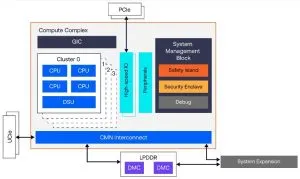
“Capabilities like real-time driver monitoring, predictive maintenance and adaptive in-vehicle infotainment, that were once limited to premium models, are becoming the standard across all tiers of new vehicles,” according to the company. “At the same time, automotive development complexity continues to grow, with evolving safety requirements and increasing demands for scalable compute.”
Within the package, called Zena CSS (‘compute sub-system’) and delivered as RTL, are:
- A 16-core Cortex-A720AE CPU
- CPU coherency and chip-to-chip IO connectivity (CMN S3AE)
- A safety island built around a Cortex-R82AE real-time processor
- A run-time security engine for secured over-the-air updates
- TrustZone for system-wide security
- Optional Mail GPU
- Optional Mali-C720AE image signal processor
- Support for non-Arm accelerators
“Our first-generation Zena CSS is a pre-validated compute platform based on Armv9 AE [automotive enhanced] technologies,” said Arm. “It brings together a dedicated safety island and run-time security engine, reference firmware and software support into a complete CSS that is ready for silicon implementation.”
Zena CSS scales, it said, from in-vehicle infotainment to central compute and Level 2+ ADAS (driver assistance), allowing vehicle makers to deploy it across multiple vehicle lines and performance tiers “without reinventing the compute stack or starting from scratch on safety certification. Zena CSS is aligned with SOAFEE [scalable open architecture for embedded edge], with the SOAFEE community developing blueprints that are enabled and built for the CSS”
These including the Autoware Open AD kit blueprint, Denso’s mixed-criticality safety blueprint and Panasonic automotive systems blueprints for digital cockpit and infotainment, it added.



